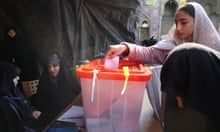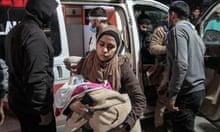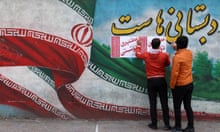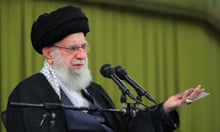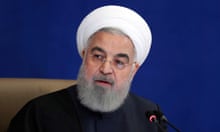The turnout in Iran’s parliamentary elections appears to have dropped to 41%, a record low, but according to the official figures, not quite to the levels of mass abstention that some surveys had predicted.
Polls closed at midnight on Friday, six hours later than planned due to what officials claimed was a second surge in polls in the evening, but Tehran’s middle class stayed away, fewer than 24% of the 8 million eligible to vote bothering to do so.
Overall, the turnout and result could leave conservatives firmly in charge and free to pursue their economic and foreign policies, but they may be weakened by internal factionalism now that reformists have largely been purged. It is possible that some relatively unknown candidates opposed to the status quo have been elected in the provinces, where hundreds of novice candidates were permitted to stand.
Divisions between fundamentalist factions led them to putting up four different slates, instead of a single slate as four years ago, meaning that it is likely many in the top 30 in Tehran will not have received the 20% of votes required to avoid a second round of elections.
Parliament’s speaker, Mohammed Baqer Qalibaf, suffered a severe rebuff, falling to fourth place on the Tehran list as his vote collapse to 94,000.
The elections covered both the 290 seats in a four-year term parliament and the eight-year terms for the 88 seat Assembly of Experts, the body that is likely to elect Iran’s supreme leader.
In Tehran, the most popular candidate for the assembly received only 326,000 votes, yet there are 8 million registered voters in Tehran.
Key figures who challenged the political direction of the current leadership – not just reformists, but centrists such as the former president Hassan Rouhani – were blocked from standing without explanation.
Mohammad Khatami, Iran’s first reformist president, was among critics who did not vote on Friday, despite initial false reports that he had. It is the first time he has stayed away and his decision is seen as a game-changer for reformists that have long debated the value of participating in an electoral process that many see as window-dressing designed to disguise where the true levers of power lie.
The imprisoned Nobel peace prize laureate Narges Mohammadi, a women’s rights advocate, called the election a “sham” in a statement shared by her family with Reuters.
Mahmoud Sadeghi, an MP until 2020, called the decrease in participation in the elections “a big warning to the government and the ruling faction. Instead of denying the reality and falsely claiming victory, take this warning seriously and submit to structural reforms to make the elections meaningful” in a post on social media.
He wrote that “in the previous election, when 42.5% participation was announced, they said it was because of corona[virus]. Now reaching below this quorum is a victory for them!”
The polls were especially significant given that they were the first since the regime crushed the ”Women, life, freedom” protest movement.
The final official turnout will be announced later, and critics say is open to distortion since voters who went to the polls to spoil the ballot paper are also included.
But some Iranian papers welcomed what they saw as a high turnout. Hamshahri newspaper, referring to the 25 million who did vote, said it was a slap in the face of America: “The participation of more than 41% of the people in the elections foiled the plans of the enemies. The biggest election boycott campaign in the last 45 years failed.”
Nevertheless, this turnout represents the lowest in the history of the Islamic Republic’s legislative elections. Turnout in 2020 was 42.6%, while in 2016 it reached 61.6% and in 2012 it was 63.9%.
As previously, turnout in major cities is significantly lower than in small towns and rural areas. In Tehran, only 24% of the eligible population voted, a 2% decrease from 2020.
A distinctive feature of the elections was the number of no-hopers who were allowed to run. In 2020, about 7,500 candidates were deemed qualified to run. This year, the number doubled to 15,000, most of the increase occurring in small towns and rural areas. Local rivalries between villages and small towns have become a key factor in driving people to the polls.
Iranian officials were eager to ensure that turnout did not substantially drop below the 42.3% record low of four years ago, which officials blamed on Covid and disillusionment with the Rouhani government.
One young Iranian said he did not know anyone of his generation who voted. “Most of us do not know the candidates, and anyway the parliament has no powers since everything is vetted by the guardian council,” he said. “It is seen as a joke.”
The Guardian was not provided with a visa to cover the election.

